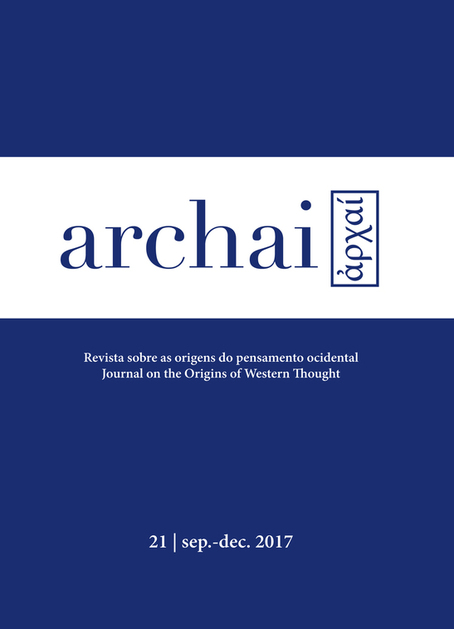The concept of the Sun as ἡγεμονικόν in the Stoa and in Manilius’ Astronomica
DOI:
https://doi.org/10.14195/1984-249X_21_3Keywords:
Ancient Cosmology, Stoics, Manilius, Greek AstrologyAbstract
Hegemonikon in Stoic vocabulary is the technical term for the chief part or ‘command-centre’ of the soul. As we know, the Stoics considered the cosmos a living organism, and they theorised both about the human soul’s Hegemonikon and about its counterpart in the World-soul. My ultimate purpose in this paper is to show that the Stoic concept of the cosmic hegemonikon can be observed in Manilius’ Astronomica. The paper is divided in two parts. To begin with, I will examine and discuss the evidence concerning this concept in the relevant texts of the Early and Middle Stoa. The analysis will make clear that by the time of Manilius the concept of hegemonikon involved a background of astronomical theory introduced by the Stoic Posidonius. In the second section, I will go on to relate the concept of hegemonikon to the doctrines conveyed by Manilius. Additionally, we shall see that Manilius’ polemic allusions to Lucretius’ De Rerum Naturasuggest that the concept was intensely debated in the Post-Hellenistic philosophical circles.
Downloads
References
BOWEN, A. C.; TODD, R. B. (2004). Cleomedes’ Lectures on Astronomy: A Translation of The Heavens with an Introduction and Commentary. Berkeley and Los Angeles, University of California Press.
BOYANCÉ, P. (1936). Études sur le Songe de Scipion : essais d”ºhistoire et de psychologie religieuses. Bordeaux, Feret & Fils.
EDELSTEIN, L.; KIDD, I. G. (1972). Posidonius, Vol. I: The Fragments. Cambridge,CUP.
FERABOLI, S.; FLORES, E.; SCARCIA, R. (1996-2001). Manilius: Il poema degli Astri (Astronomica). 2 vols. (n.p.) Milano, Mondadori.
GALE, M. R. (2009). De rerum natura V. Oxford, Oxbow Books.
GARANI, M. (2007). Empedocles redivivus: poetry and analogy in Lucretius. New York, London: Routledge.
GEE, E. (2013). Aratus and the astronomical tradition. Oxford, Oxford University Press.
GOOLD, G. P. (1997). Manilius: Astronomica. 2nd edn. Cambridge, Mass., Harvard University Press.
GREEN, S. AND Volk, K. (eds.) (2011). Forgotten Stars: Rediscovering Manilius’ Astronomica. Oxford, Oxford University Press.
HAHM, D. E. (1977). The origins of Stoic cosmology. [Columbus], Ohio State University Press.
HÜBNER, W. (1982). Die Eingenschaften der Tierkreiszeichen in der Antike. Ihre Darstellung und Verwendung unter besonderer Berücksichtigung des Manilius. Sudhoffs Archiv, Beiheft 22. Wiesbaden.
KEYSER, P. T. (1994). ‘On Cometary Theory and Typology from Nechepso-Petosiris to Apuleius through Servius’. Mnemosyne 47, p. 625−651.
KEYSER, P. T. (2009). ‘Heliocentrism in or out of Heraclides’ in Fortenbaugh & Pender, eds., Heraclides of Pontos: Discussion. Rutgers University Studies in Classical Antiquity. New Brunswick (NJ), Transaction Publishers. p. 205-235. https://doi.org/10.1163/156852594X00528
KIDD, I. G. (1988). Posidonius: The Commentary (vols. I and II). Cambridge, CUP.
KIDD, I. G. (1999). Posidonius: The translation of the Fragments. Cambridge, CUP.
LAPIDGE, M. (1989). ‘Stoic Cosmology and Roman Literature. First to Third Centuries A.D.’ ANRW 2. 36. 3, p. 1379-429.
LONG, A. A.; Sedley D, N. (1987). The Hellenistic Philosophers (vols. I and II). Cambridge, Cambridge
University Press. https://doi.org/10.1017/CBO9780511808050
LÜHR, F. -F. (1969). Ratio und Fatum.Dichtung und Lehre bei Manilius. Inaug. Diss. Frankfurt.
MONTANARI CALDINI, R. (1989). ‘Manilio tra scienza e filosofia: la dottrina delle comete’. Prometheus 15, p.1-30.
RAMELLI, I. (2014). Manilius and Stoicism. In GARANI, M.; KONSTAN, D. (eds.). The philosophizing muse: the influence of Greek philosophy on Roman poetry. Newcastle upon Tyne, Cambridge Scholars Press.
REEH, A. (1973). Interpretationen zu den Astronomica des Manilius mit besonderer Berücksichtigung der philosophischen Partien. Diss. Marburg.
RÖSCH, H. L. (1911). Manilius und Lucrez. Diss. Kiel.
SALEMME, C. (1983). Introduzione agli Astronomica di Manilio. Naples, Loffredo.
SALLES, R. (2009). Chrysippus on Conflagration and the Indestructibility of the Cosmos’. In SALLES, R. (ed.). God and cosmos in Stoicism. Oxford, OUP, p.118−34. https://doi.org/10.1093/acprof:oso/9780199556144.003.0006
SCHMIDT, J. (1990). Lukrez, der Kepos und die Stoiker : Untersuchungen zur Schule Epikurs und zu den Quellen von “De rerum natura”. Frankfurt am Main, Peter Lang.
SCHRIJVERS, P. H. (1983). Le Chant du Monde: Remarques sur Astronomica I 1-24 de Manilius. Mnemosyne 36, p.143-50. https://doi.org/10.1163/156852583X00089
SCHWARZ, W. (1972). Praecordia mundi. Zur Grundlegung der Bedeutung des Zodiac bei Manilius. Hermes 100, p.601-14.
TODD, R. B. (2001). Cleomedes and the Problems of Stoic Astrophysics. Hermes 129: p. 75-78.
VOLK, K. (2009). Manilius and his Intellectual Background. Oxford, OUP. https://doi.org/10.1093/acprof:oso/9780199265220.001.0001
WALSH, P. G. (1997). The nature of the gods /Cicero. Oxford, Clarendon Press.
WARDLE, D. (2006). Cicero on Divination. De Divinatione, Book 1. Oxford: Clarendon Press.
WHITE, S. (2007). Posidonius and Stoic Physics. In SORABJI, R.; SHARPLES, R.W. (eds.) Greek and Roman philosophy, 100 BC - 200 AD (2 vols.). London, University of London, School of Advanced Study, Institute of Classical Studies. p. 35-76. https://doi.org/10.1111/j.2041-5370.2007.tb02417.x
Downloads
Published
How to Cite
Issue
Section
License
Given the public access policy of the journal, the use of the published texts is free, with the obligation of recognizing the original authorship and the first publication in this journal. The authors of the published contributions are entirely and exclusively responsible for their contents.
1. The authors authorize the publication of the article in this journal.
2. The authors guarantee that the contribution is original, and take full responsibility for its content in case of impugnation by third parties.
3. The authors guarantee that the contribution is not under evaluation in another journal.
4. The authors keep the copyright and convey to the journal the right of first publication, the work being licensed under a Creative Commons Attribution License-BY.
5. The authors are allowed and stimulated to publicize and distribute their work on-line after the publication in the journal.
6. The authors of the approved works authorize the journal to distribute their content, after publication, for reproduction in content indexes, virtual libraries and similars.
7. The editors reserve the right to make adjustments to the text and to adequate the article to the editorial rules of the journal.



